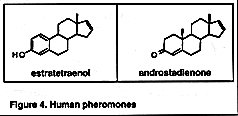Comparison of Synthetic and Natural Pheromones
Many times, synthetic pheromones that are used in pest control, insect monitoring, etc. are successful, as mentioned in the "use of synthetic pheromones" section. Scientists can actually trick insects into thinking the synthetic pheromones are actually natural pheromones released by other insects. Therefore, there is not much debate about whether or not synthetic pheromones used for insect control are effective and similar to natural insect pheromones. The controversial comparison is between human pheromones and the synthetic human pheromones, now being produced and added to colognes, perfumes, etc.
The pheromones that are located in the perfumes are actually androstenone and androstenal, or known to critics as "pig pheromones". Females have a higher sensitivity to androstenone associated with a stronger response to male body odors. The question is, do these chemicals have the same effects as natural human pheromones?("Sensitivity to androstenone in female subjects is associated with an altered brain response to male body odor", Physiology and Behavior, 1999, 68:129-37)
